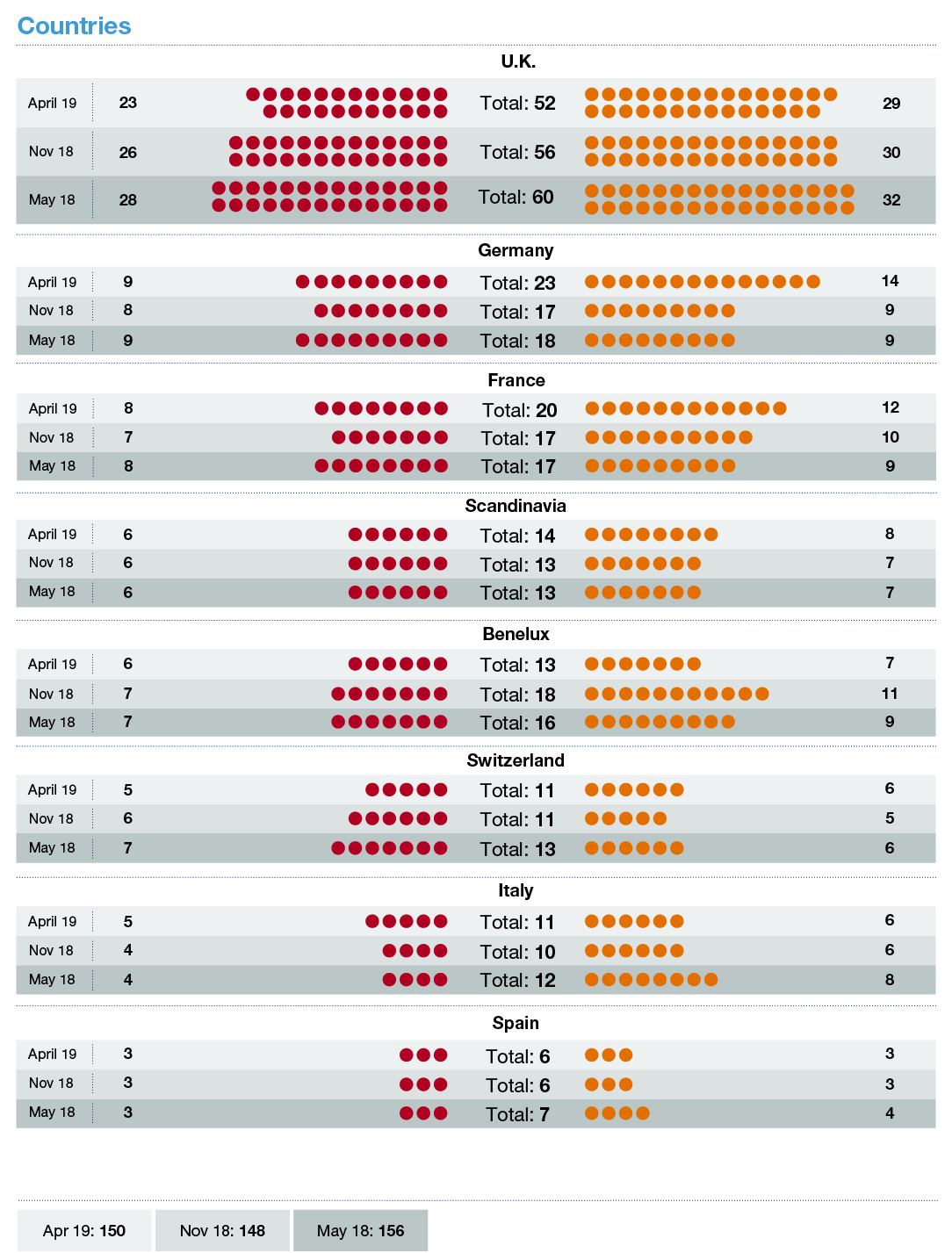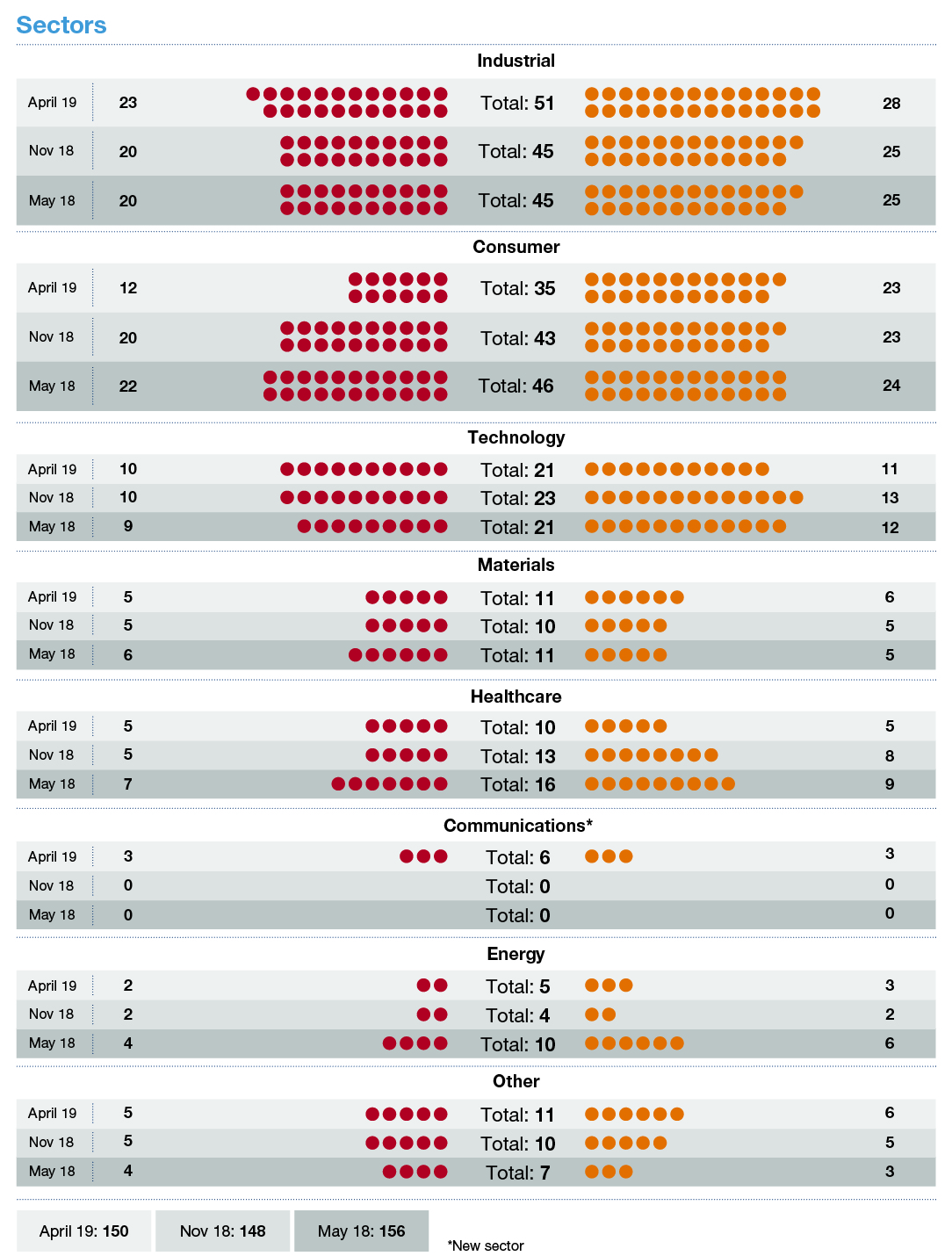Activists Set Their Sights on Continental Europe
While U.K. remains top European market for activism, Germany and France are increasingly at risk; Industrials and Technology identified as key sectors at risk, while Consumer firms continue to fall out of favour.
Global professional services firm Alvarez & Marsal (“A&M”) today announces the findings of its latest analysis and predictor of shareholder activism in Europe, the “A&M Activist Alert”, or “AAA”. The study predicts significant growth of activism across the Continent, with the key sectors to watch identified as Industrials and Technology. However, of the 150 European companies predicted to be under threat from public activist targeting, 52 of these are still U.K. companies.
-
Activists have started to turn their sights on Continental European companies. Early signs show that they are successfully honing their tactics to better suit European markets – often taking a less confrontational approach than traditional U.S. campaigns.
-
Indeed, between 2016 and 2017, 67 percent of European companies targeted by activists faced calls for boardroom changes. From 2018 to date, this proportion declined to 58 percent – the fall could illustrate activists adopting a more “constructivist” approach and seeking to co-operate with the existing board.
-
Markets predicted to face increased threat of activism are Germany (23 in total – up from 17) and France (20 in total – up from 17). These represent 35 percent and 18 percent increases respectively since our November 2018 report.
-
As Continental European companies grow in attraction, the U.K.’s projected share of activist targets in Europe is falling: from 38 percent in 2017 to 36 percent last year and a forecast 35 percent in the next 12 months.
-
However, the U.K. remains Europe’s single largest hunting ground for activists, with 52 companies in this jurisdiction predicted to face imminent threat of activism.
-
There is no clear Brexit effect so far. Its disruption is anticipated to lead to greater opportunities for activists. Corporates that do not respond well will bring themselves to the attention of activists and a weakening of sterling could prompt greater interest in buyouts and public-to-private deals.
Sector and developing trends
-
M&A is becoming an increasingly common feature of activist campaigns. In 2017 and 2018, 12 percent of demands made by activist investors related to potential M&A – this has risen to 17 percent during the first three months of 2019. A clear driver for this trend is the large number of calls for conglomerates to sell underperforming divisions and focus on core activities.
-
Industrials companies continue to be the most at-risk sector group for activists in Europe (51 in total), in part, due to many operating under conglomerate structures.
-
Technology firms – again, particularly conglomerates – are also predicted to be a key sector to watch for activists (21 in total), given the substantial opportunities to drive operational improvements.
-
Consumer companies have continued to become less attractive to activists (35 in total are now on the hit list, down from 43 in November 2018). A key factor behind this is that many offline retailers are now too distressed to attract activist interest.
-
If corporates wish to avoid a public activist approach, they have less than two years from when they first show weakened performance to demonstrate tangible improvements in their published results.
-
A key trend expected to grow in the coming years is the emergence of activists seeking to take companies private. This allows them to retain the full benefit of improved performance rather than holding a minority public stake and so sharing any benefit with other shareholders.
Malcolm McKenzie, Managing Director and Head of European Corporate Transformation Services, said: “There are real signs of activism growing in Europe. The U.K. is still the favorite market for activists, but activists have started to make serious inroads into Continental Europe, and we see this trend accelerating. While no sector is immune, conglomerates will find themselves on notice, as calls for breakups remain a key activist tactic."
“The best defence against an activist is planned and enacted, not in the battle – but at least two years earlier, when underperformance typically starts. Corporate governance must not be overlooked either, as poor practices are a magnet for activists. Boards in the U.K. and on the Continent must hunt out areas of sub-par performance and drive a programme to ensure that they are demonstrating maximum shareholder value and long-term thinking.”
A&M Activist Alert
The AAA is the most comprehensive statistical analysis of its kind. The analysis focuses on 1,473 corporates with a market capitalization of US$200 million or more, listed and headquartered in the U.K., Germany, France, Scandinavia, Switzerland, Benelux, Italy and Spain. The resulting predictive model successfully predicted the majority of corporates publicly targeted by activists since January 2015. The report is published twice yearly and individual companies can check their position on the Alert List by contacting A&M.
Further notes
The AAA model
Key findings summarized:


Quarterly refreshes
The A&M Activist Alert model is fully reassessed and refreshed every three months including a fully updated review of all known activist actions. This allows us to see how the key variables, timescales, country and industry factors have moved in terms of relative importance. A&M also reviews which companies have moved in or out of the Red or Amber Lists.
This April 2019 analysis is accompanied by a focused report that explains the methodology plus the key findings and clear messages of importance to corporates and their Boards seeking to avoid the high potential financial and reputational costs associated with a public activist programme. Individual companies can check their position on the Alert List by contacting A&M.
Red and Amber Lists
The AAA model calculates a score for all analyzed corporates that predicts the likelihood of public activist action. Companies with high AAA Scores, and therefore with a higher predicted likelihood of public targeting, are classified as either Red or Amber. These classifications are based on the level of AAA Score and how sustained it has been over the past two years.
Corporates with high AAA Scores on both the two year and one year bases are considered to be at high short term risk (next six to 12 months) of public activist action and may already be subject to non-public approaches. Such high-risk corporates feature on the Red List. Companies with a high AAA Score on either the two year or one year basis are likely to be being monitored by activists. Such companies are considered to be at medium risk which will only increase if corrective action is not taken within 12 to 18 months. Such medium risk corporates feature on our “Amber List”.
About Alvarez & Marsal
Companies, investors and government entities around the world turn to Alvarez & Marsal (A&M) when conventional approaches are not enough to make change and achieve results. Privately held since its founding in 1983, A&M is a leading global professional services firm that provides advisory, business performance improvement and turnaround management services.
With over 3,500 people across four continents, we deliver tangible results for corporates, boards, private equity firms, law firms and government agencies facing complex challenges. Our senior leaders, and their teams, help organizations transform operations, catapult growth and accelerate results through decisive action. Comprised of experienced operators, world-class consultants, former regulators and industry authorities, A&M leverages its restructuring heritage to turn change into a strategic business asset, manage risk and unlock value at every stage of growth.
To learn more, visit: AlvarezandMarsal.com. Follow A&M on LinkedIn, Twitter and Facebook.

